Effect of Heat Treatment Process on Microstructure and Mechanical Properties of High-Carbon H13 Steel
Abstract
:1. Introduction
2. Materials and Methods
- (1)
- H1 (vacuum furnace gas quenching): ① Entered the furnace at room temperature, raised the temperature to 650 °C, and kept the temperature for 150 min; ② raised the temperature to 850 °C and kept the temperature for 120 min; ③ raised the temperature to 1040 °C and kept the temperature for 90 min; ④ vacuum gas quenched to a temperature below 80 °C for furnace discharge and left at room temperature, as shown in Figure 3a.
- (2)
- H2 (vacuum gas quenching–deep cooling process): ① Entered the furnace at room temperature, raised the temperature to 650 °C, and kept the temperature for 150 min; ② raised the temperature to 850 °C and kept the temperature for 120 min; ③ raised the temperature to 1040 °C and kept the temperature for 90 min; ④ vacuum gas quenched to a temperature below 80 °C for furnace discharge; ⑤ deep cooling temperature of −80 °C, insulation for 90 min, cooled to around −30 °C and taken out of furnace and left at room temperature, as shown in Figure 3b.
- (3)
- H3 (vacuum oil quenching–deep cooling process): ① Entered the furnace at room temperature, raised the temperature to 650 °C, and kept the temperature for 150 min; ② raised the temperature to 850 °C and kept the temperature for 120 min; ③ raised the temperature to 1040 °C and kept the temperature for 90 min; ④ vacuum oil quenched to a temperature below 40 °C for furnace discharge; ⑤ deep cooling temperature of −80 °C, insulation for 90 min, cooled to around −30 °C and taken out of furnace and left at room temperature, as shown in Figure 3c.
- (4)
- H4 (spheroidizing annealing–vacuum gas quenching–deep cooling process): ① Heated to 860 ± 10 °C, kept the temperature for 120 min, quickly cooled to 700 ± 10 °C (near A1 line), and then kept the temperature for 480 min. Afterwards, cooled at a rate of 30–50 °C/h to 600 °C for furnace discharge, air cooled to room temperature, and completed spheroidization; ② entered the furnace to raise the temperature to 650 °C and kept the temperature for 150 min; ③ raised the temperature to 850 °C and kept the temperature for 120 min; ④ raised the temperature to 1040 °C and kept the temperature for 90 min; ⑤ vacuum gas quenched to a temperature below 80 °C for furnace discharge; ⑥ deep cooling temperature of −80 °C, insulation for 90 min, cooled to around −30 °C and taken out of furnace and left at room temperature, as shown in Figure 3d.
3. Experimental Results and Discussion
3.1. Effect of Heat Treatment Process on Microstructure
3.2. Effect of Heat Treatment Process on Impact Toughness and Hardness
3.3. Effect of Heat Treatment Process on Wear Resistance
4. Conclusions
- (1)
- The elemental composition of high-carbon H13 steel after different heat treatments did not change much, but there was still segregation of the alloy elements and dispersion of the C-Cr mechanical mixed particles.
- (2)
- After heat treatment, the H13 steel had no diffraction peaks of multiple alloying elements, and its phases were mainly the α-Fe phase and Cr phase. The characteristic peaks observed in the XRD patterns of each sample exhibited a small deviation in peak position, which can be attributed to the formation of a solid solution through the incorporation of alloy elements into the matrix.
- (3)
- After the different heat treatment processes, fine C-Cr mechanical mixed particles could be seen dispersed in the ferrite matrix. The analysis revealed that the cryogenic process facilitated the transition from austenite to martensite, while promoting the precipitation of carbon atoms and alloy elements, resulting in the formation of numerous fine hard particles dispersed on the surface of the matrix. At the same time, the retained austenite was divided by lath martensite, and the structure was refined. The oil quenching process provided a large undercooling, promoted the precipitation of carbon atoms, formed more fine particles, improved the nucleation rate of martensite, and further refined the structure. The spheroidizing annealing process was added before the gas quenching cryogenic process to promote the melting of the original carbide and to obtain more dispersed hard particles, which inhibited the growth of the original grains and refined the structure.
- (4)
- Following heat treatment, the sample exhibited a small range of hardness variation, while displaying significant variability in impact toughness. Sample H1 had the highest hardness and the lowest impact toughness. The average hardness of sample H2 was lower than that of sample H1, but its toughness was improved. After oil quenching and cryogenic treatment, the hardness and toughness of sample H3 were improved compared with those without cryogenic treatment. Following the spheroidizing annealing process, sample H4 exhibited elevated hardness and ultra-high toughness. And its special process allowed the material to obtain the best matching between strength and toughness.
- (5)
- After the different heat treatments, the change trend of the wear resistance and hardness was consistent, that is, the higher the hardness, the better the wear resistance. While maintaining high wear resistance, the toughness of sample H4 was notably enhanced, resulting in an improved performance of the material. The process was an ideal heat treatment process for the high-carbon H13 steel used for shield tools.
Author Contributions
Funding
Data Availability Statement
Acknowledgments
Conflicts of Interest
References
- Cai, W.; Li, L.; Shen, Y.; Wu, X. Effect of heat treatment process on microstructure and properties of 4Cr3Mo2Si1V steel. Heat Treat. Met. 2022, 47, 226–232. [Google Scholar]
- Yin, J.; Zhou, J.; Jiang, Y.; Chi, H.; Lin, P. Effect of heat treatment process on microstructure and properties of 5Cr5Mo2V steel. Heat Treat. Met. 2021, 46, 55–60. [Google Scholar]
- Shinde, T.; Pruncu, C.; Dhokey, N.B.; Parau, A.C.; Vladescu, A. Effect of Deep Cryogenic Treatment on Corrosion Behavior of AISI H13 Die Steel. Materials 2021, 14, 7863. [Google Scholar] [CrossRef]
- Ozer, M. Influence of heat treatments on microstructure and wear behavior of AISI H13 tool steel. Kov. Mater. Met. Mater. 2022, 60, 387–396. [Google Scholar] [CrossRef]
- Karkalos, N.E.; Markopoulos, A.P. 6—Modeling of hard machining. In Computational Methods and Production Engineering; Woodhead Publishing: Cambridge, UK, 2017; pp. 171–198. [Google Scholar]
- Peng, F.; Zhang, L.; Wang, P. Effect of high temperature quenching process onmicrostructure and properties of 4Cr5MoSiV1 steel. Heat Treat. Met. 2018, 43, 123–127. [Google Scholar]
- Coldwell, H.; Woods, R.; Paul, M.; Koshy, P.; Dewes, R.; Aspinwall, D. Rapid machining of hardened AISI H13 and D2 moulds, dies and press tools. J. Mater. Process. Technol. 2003, 135, 301–311. [Google Scholar] [CrossRef]
- Wang, J.; Xu, Z.; Lu, X. Effect of the Quenching and Tempering Temperatures on the Microstructure and Mechanical Properties of H13 Steel. J. Mater. Eng. Perform. 2020, 29, 1849–1859. [Google Scholar] [CrossRef]
- ISO 148-1: 2016; Metallic Materials—Charpy Pendulum Impact Test—Part 1: Test Method. ISO: Geneva, Switzerland, 2016.
- ISO 945-1: 2019; Microstructure of Cast Irons—Part 1: Graphite Classification by Visual Analysis. ISO: Geneva, Switzerland, 2019.
- ISO 21068-1: 2008; Chemical Analysis of Silicon-Carbide-Containing Raw Materials and Refractory Products—Part 1: General Information and Sample Preparation. ISO: Geneva, Switzerland, 2008.
- ISO 6508-1: 2016; Metallic Materials—Rockwell Hardness Test—Part 1: Test Method. ISO: Geneva, Switzerland, 2016.
- ISO 7148-1: 2012; Plain Bearings—Testing of the Tribological Behaviour of Bearing Materials—Part 1: Testing of Bearing Metals. ISO: Geneva, Switzerland, 2012.
- Jovičević-Klug, P.; Jenko, M.; Jovičević-Klug, M.; Batič, B.; Kovač, J.; Podgornik, B. Effect of deep cryogenic treatment on surface chemistry and microstructure of selected high-speed steels. Appl. Surf. Sci. 2021, 548, 149257. [Google Scholar] [CrossRef]
- Li, D.; Xiao, M.; Sun, H.; He, W.; Zhang, X. Effect of deep cryogenic treatment on microstructure and thermal stability of H13 steel. Iron Steel 2020, 55, 95–102. [Google Scholar]
- Gecu, R. Combined effects of cryogenic treatment and tempering on microstructural and tribological features of AISI H13 steel. Mater. Chem. Phys. 2022, 292, 126802. [Google Scholar] [CrossRef]
- Zhao, X.; Wang, B.; Sun, D.; Li, C.; Han, L.; Gu, J. Effect of pre-existing VC carbides on nitriding and wear behavior of hot-work die steel. Appl. Surf. Sci. 2019, 486, 179–186. [Google Scholar] [CrossRef]
- Zhang, Z.; Liu, H.; Wang, M.; Ge, X.; Fan, B. Effect of cryogenic treatment on microstructure and wear resistance of spray formed H13 steel. Heat Treat. Met. 2017, 42, 86–90. [Google Scholar]
- Rao, C.; Zhang, X. Influence of deep cryogenic treatment on wear properties for 4Cr5MoSiV1 hot work die steel. Forg. Stamp. Technol. 2022, 47, 235–240. [Google Scholar]
- Jurci, P.; Durica, J.; Dlouhy, I.; Horník, J.; Planieta, R.; Kralovič, D. Application of-140 degrees C Sub-Zero Treatment for Cr-V Ledeburitic Steel Service Performance Improvement. Metall. Mater. Trans. A-Phys. Metall. Mater. Sci. A 2019, 50, 2413–2434. [Google Scholar] [CrossRef]
- Ai, Y.; Liu, Z.; Chen, W.; Zhu, Z.; Luo, G.; Liang, B. Effect of quenching process on microstructure and mechanical properties of H13 steel. Heat Treat. Met. 2021, 46, 144–150. [Google Scholar]
- Liu, Z. Research on Heat Treatment and Cryogenic Treatment Characteristics of H13E Hot Work Die Steel. Masters’ Thesis, Nanchang Hangkong University, Nanchang, China, 2021. [Google Scholar]
- López-Leyva, A.; Luis-Pantoja, G.; Juárez-Islas, J.A.; Mejía-Caballero, I.; Campos-Silva, I. Influence of Heat and Cryogenic Treatments on the Abrasive Wear Behavior of H13 Tool Steel. J. Mater. Eng. Perform. 2023, 32, 10254–10264. [Google Scholar] [CrossRef]
- Zou, A.; Deng, F.; Deng, P. Effect of isothermal spheroidization on microstructure and properties of steel H13. Heat Treat. Met. 2003, 28, 34–35. [Google Scholar]
- Zhu, J.; Lin, G.; Zhang, Z.; Xie, J. The martensitic crystallography and strengthening mechanisms of ultra-high strength rare earth H13 steel. Mater. Sci. Eng. A-Struct. Mater. Prop. Microstruct. Process. 2020, 797, 140139. [Google Scholar] [CrossRef]
- Li, B.; Zhang, T.; Zhang, S. Deep cryogenic treatment of carbide tool and its cutting performances in hard milling of AISI H13 steel. Procedia CIRP 2018, 71, 35–40. [Google Scholar] [CrossRef]
- Jovicevic-Klug, P.; Jovicevic-Klug, M.; Podgornik, B. Effectiveness of deep cryogenic treatment on carbide precipitation. J. Mater. Res. Technol. 2020, 9, 13014–13026. [Google Scholar] [CrossRef]
- Çiçek, A.; Ekici, E.; Kıvak, T.; Kara, F.; Uçak, N. Performance of Multilayer Coated and Cryo-treated Uncoated Tools in Machining of AISI H13 Tool Steel-Part 2: HSS End Mills. J. Mater. Eng. Perform. 2021, 30, 3446–3457. [Google Scholar] [CrossRef]
- Shinde, T. Influence of carbide particle size on the wear performance of cryogenically treated H13 die steel. Surf. Eng. 2021, 37, 1206–1214. [Google Scholar] [CrossRef]
- Zhang, X.; He, W.; Wei, X.; Li, J.; Guo, H.; Li, S. Effect of cryogenic treatment on microstructure and thermal fatigue properties of H13 steel. Heat Treat. Met. 2021, 46, 81–85. [Google Scholar]
- Ma, M.; Lei, D. Heat treatment process and research status of H13 steel. HeatTreatment Technol. Equip. 2023, 44, 13–16. [Google Scholar]
- Guo, Z.; Lian, M.; Zhuo, X.; Ye, L.; Cao, P.; Wang, C.; Shang, Q. Effect of isothermal time in spheroidizing annealing on microstructure and properties of high carbon H13 steel. Heat Treat. Met. 2022, 47, 103–107. [Google Scholar]
- Katoch, S.; Sehgal, R.; Singh, V. Wear behavior of differently cryogenically treated AISI H13 steel against cold work steel. Proc. Inst. Mech. Eng. Part E-J. Process Mech. Eng. 2019, 233, 292–305. [Google Scholar] [CrossRef]
- Sola, R.; Veronesi, P.; Giovanardi, R.; Merlin, M.; Garagnani, G.L.; Soffritti, C.; Morri, A.; Parigi, G. Influence of a post-tempering cryogenic treatment on the toughness of the AISI M2 steel. In ICS 2018—7th International Congress on Science and Technology of Steelmaking: The Challenge of Industry 4.0; Associazione Italiana di Metallurgia: Milano, Italy, 2018. [Google Scholar]
- Jurči, P.; Dománková, M.; Hudáková, M.; Ptačinová, J.; Pašák, M.; Palček, P. Characterization of microstructure and tempering response of conventionally quenched, short- and long-time sub-zero treated PM Vanadis 6 ledeburitic tool steel. Mater. Charact. 2017, 134, 398–415. [Google Scholar] [CrossRef]
- Han, J.; Shao, Z.; Song, Y.; Chen, X.; Ding, B.; Gu, J. Effect of heat treatment on microstructure and properties of 4Cr5MoSiV1 steel for needle valve body. Heat Treat. Met. 2022, 47, 120–124. [Google Scholar]
- Han, W.; Zhang, Y.; Wang, Y.; Song, K.; Zhang, S. Supercooled austenite continuous cooling transformation curve of 4Cr5MoSiV1Ti steel. Mater. Mech. Eng. 2020, 44, 93–96. [Google Scholar] [CrossRef]
- Jagota, V.; Sharma, R.K. Interpreting H13 steel wear behavior for austenitizing temperature, tempering time and temperature. J. Braz. Soc. Mech. Sci. Eng. 2018, 40, 219. [Google Scholar] [CrossRef]
- Zhang, S.; Wang, D. Effect of four spheroidizing process on microstructure and Brinell hardness of H13 steel. J. Baotou Vocat. Tech. Coll. 2020, 21, 16–18-26. [Google Scholar]
- Prudente, W.R.; Lins, J.F.C.; Siqueira, R.P.; Priscila, S.N. Microstructural evolution un-der tempering heat treatment in AISI H13 hot-work tool steel. Int. J. Eng. Res. Appl. 2017, 7, 67–71. [Google Scholar]
- Wan, X.; Chen, R.; Wang, Y.; Liu, J.; Li, C. Effect of heat treatment process on microstructure and properties pf H13 hot-working die steel. Wide Heavy Plate 2020, 26, 18–22, 35. [Google Scholar]
- Koneshlou, M.; Asl, K.M.; Khomamizadeh, F. Effect of cryogenic treatment on microstructure, mechanical and wear behaviors of AISI H13 hot work tool steel. Cryogenics 2011, 51, 55–61. [Google Scholar] [CrossRef]


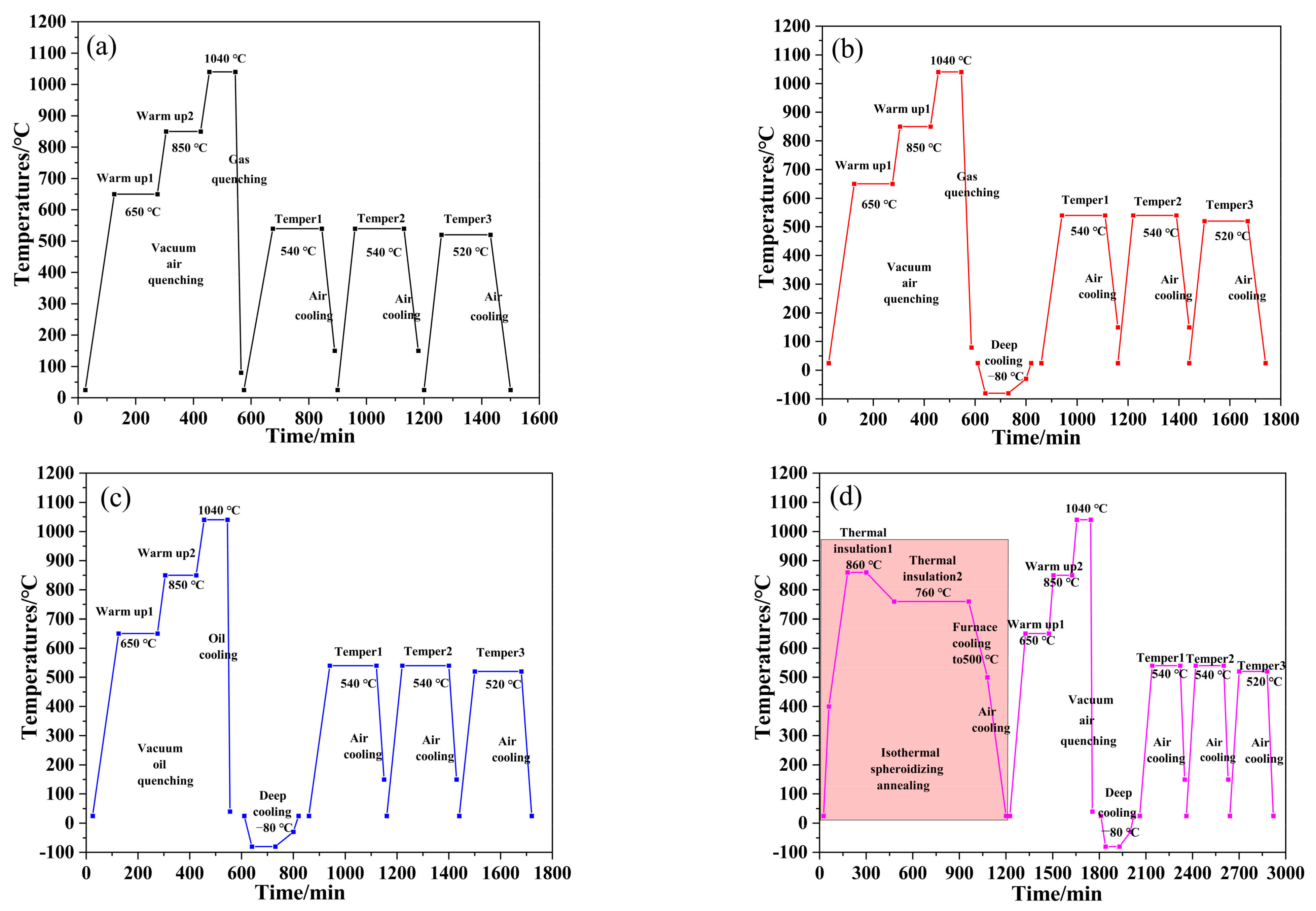
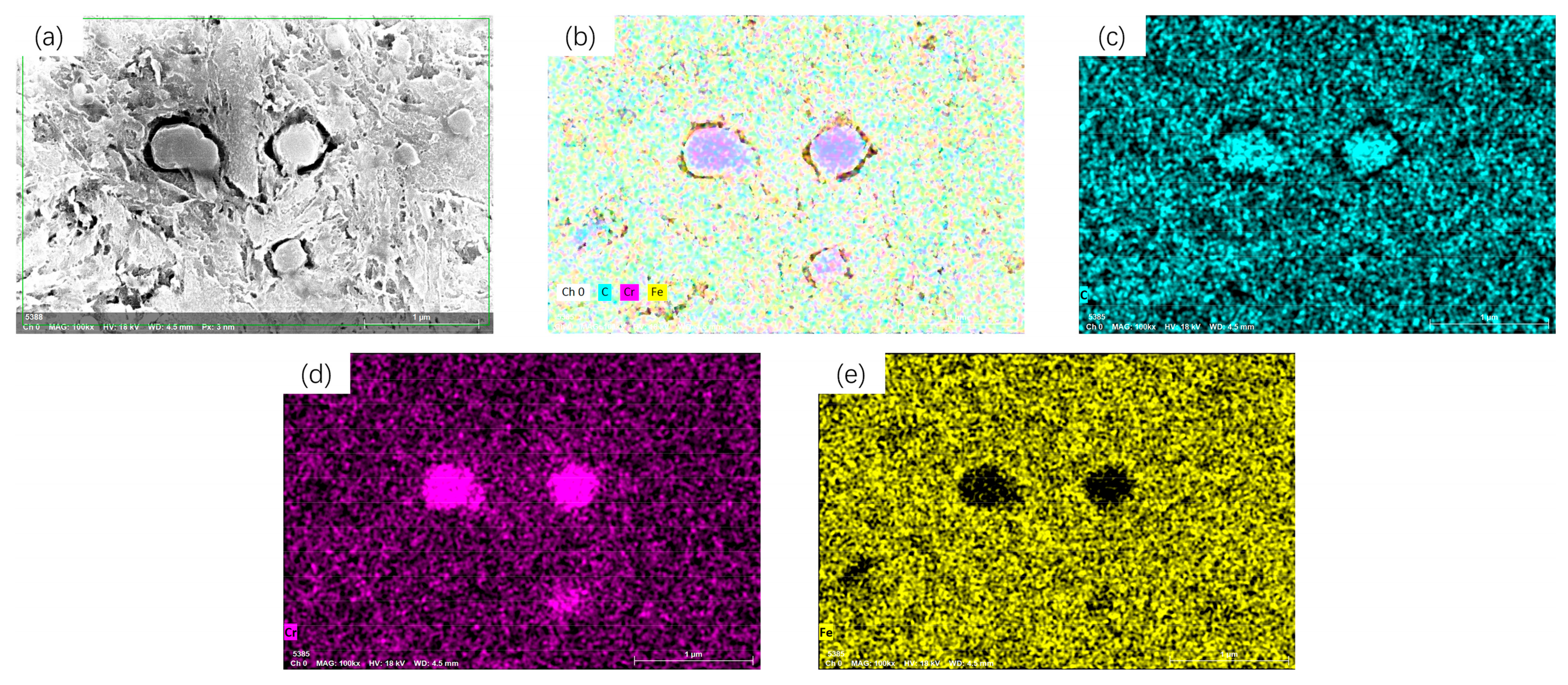

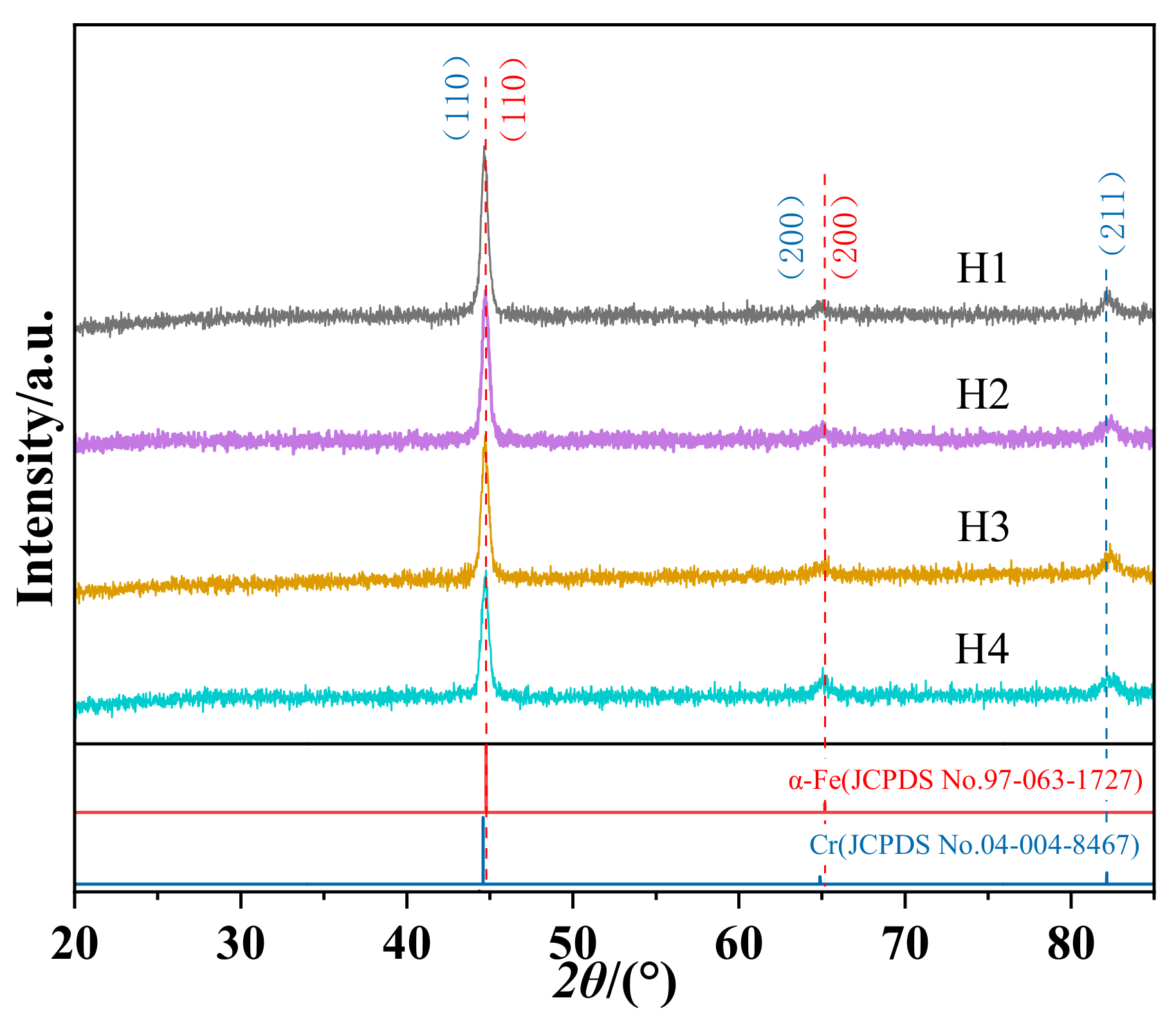

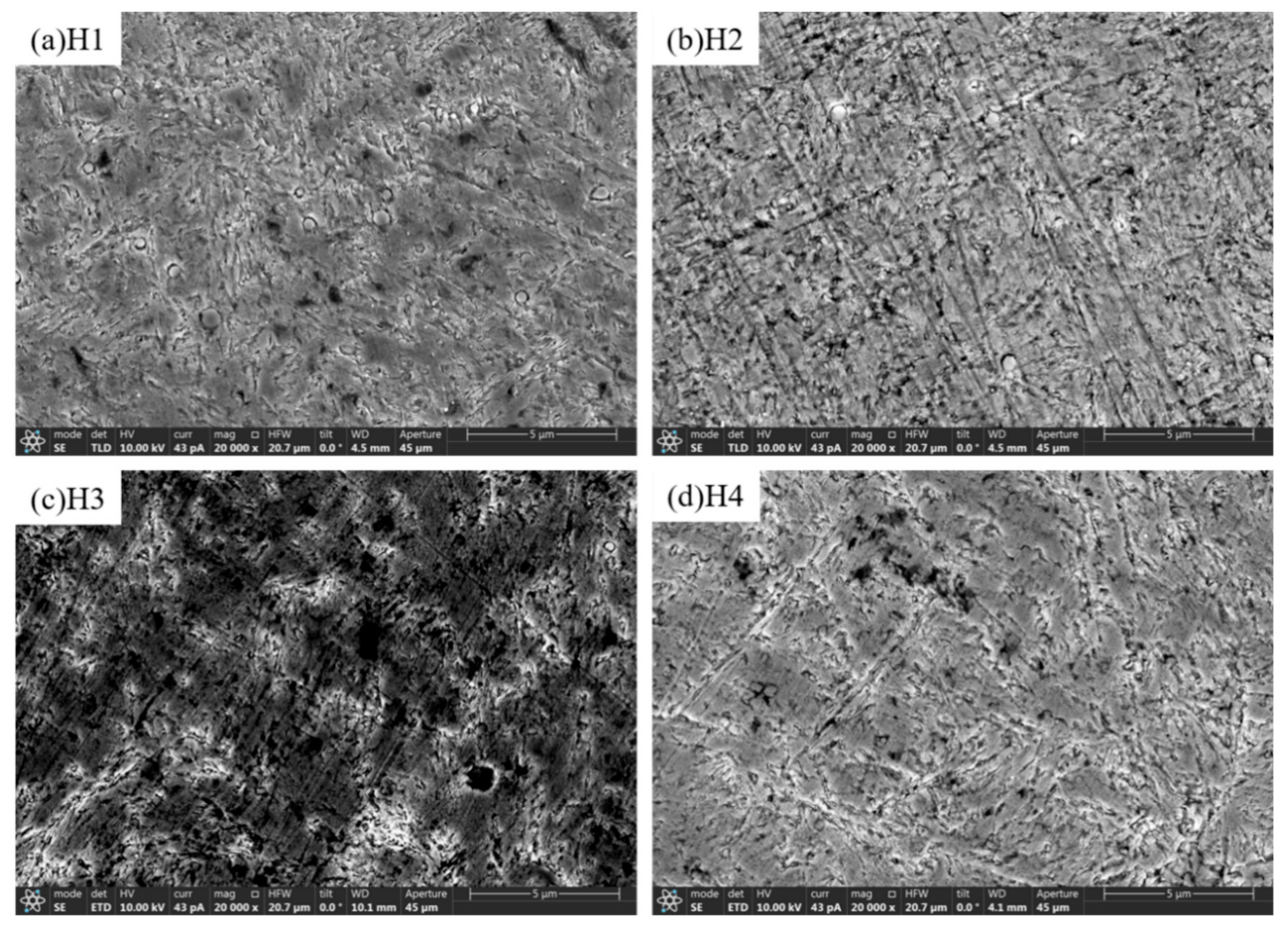

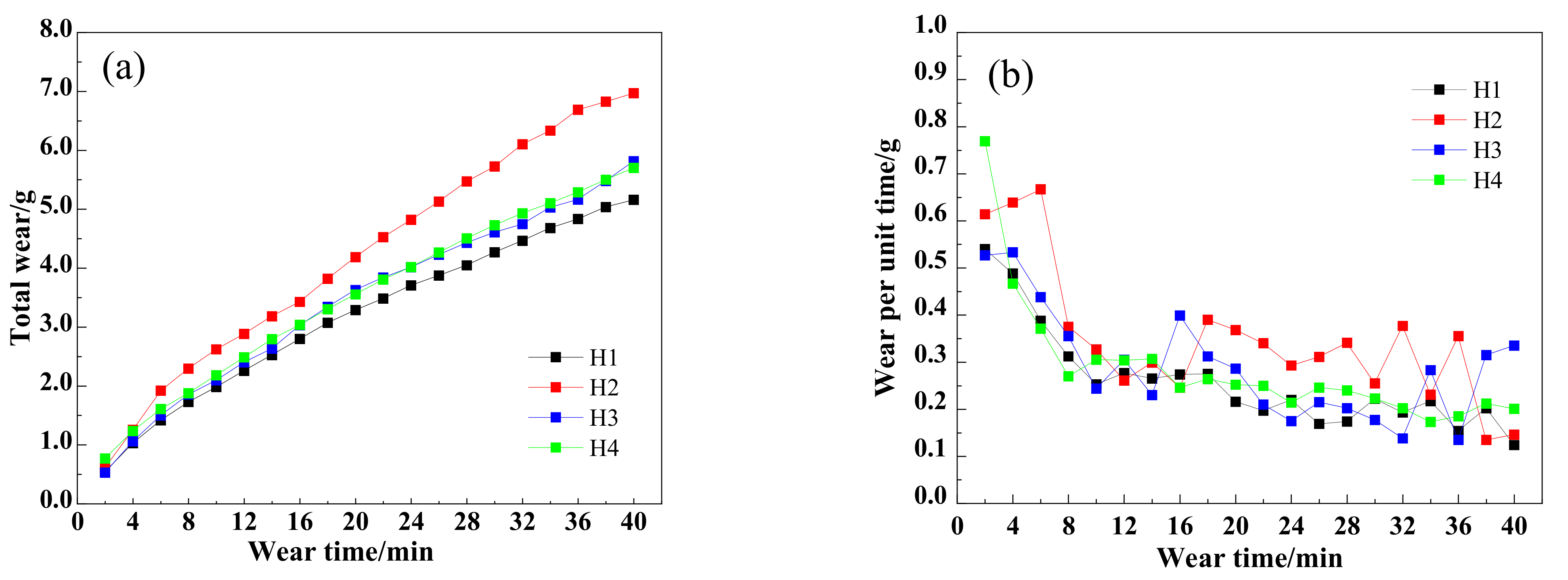
| C | Si | Mn | Cr | Mo | V | Nb |
|---|---|---|---|---|---|---|
| 0.58 | 1.0 | 0.4 | 4.85 | 1.4 | 0.9 | 0.05 |
| Technology | 2θ1 (110) | 2θ2 (200) | 2θ3 (211) |
|---|---|---|---|
| H1 | 44.622 | 64.869 | 82.135 |
| H2 | 44.738 | 65.024 | 82.406 |
| H3 | 44.661 | 65.140 | 82.290 |
| H4 | 44.757 | 64.985 | 82.174 |
| Heat-Treated Sample | Relative Position of Sample | Hardness Value/HRC | Average Hardness/HRC | Hardness Standard Deviation | Impact Energy/J | Average Impact Energy/J | Standard Deviation of Impact Energy | ||||||
|---|---|---|---|---|---|---|---|---|---|---|---|---|---|
| 1 | 2 | 3 | 4 | 1 | 2 | 3 | 4 | ||||||
| H1 | Upper left | 58.5 | 59.5 | 58 | 58 | 58.5 | 0.707 | 39 | 38.5 | 41.5 | 41.5 | 40.1 | 1.601 |
| Upper right | 59 | 58 | 57.5 | 60 | 58.63 | 1.109 | 52.5 | 56 | 43 | 42 | 48.4 | 6.945 | |
| Bottom left | 58 | 58 | 59.5 | 58.5 | 58.5 | 0.707 | 44 | 40 | 44 | 40 | 42.0 | 2.309 | |
| Bottom right | 58 | 58 | 59 | 58 | 58.25 | 0.5 | 72 | 60 | 47 | 47 | 56.5 | 12.014 | |
| Average | 58.38 | 58.38 | 58.5 | 58.63 | 58.47 | 51.88 | 48.63 | 43.88 | 42.63 | 46.75 | |||
| H2 | Upper left | 57.5 | 57.5 | 57 | 58 | 57.50 | 0.408 | 62 | 77 | 70 | 74 | 70.75 | 6.5 |
| Upper right | 57.5 | 57 | 58 | 57.5 | 57.50 | 0.408 | 85 | 67 | 67 | 56 | 68.75 | 12.010 | |
| Bottom left | 57.5 | 57.5 | 58 | 58 | 57.75 | 0.289 | 68 | 78 | 78 | 70 | 73.50 | 5.260 | |
| Bottom right | 57 | 57.5 | 57 | 57 | 57.13 | 0.25 | 90 | 63 | 61 | 57 | 67.75 | 15.042 | |
| Average | 57.38 | 57.38 | 57.5 | 57.63 | 57.47 | 76.25 | 71.25 | 69 | 64.25 | 70.19 | |||
| H3 | Upper left | 58.5 | 58 | 59 | 59 | 58.38 | 0.479 | 80 | 75 | 70 | 78 | 75.75 | 4.349 |
| Upper right | 58.5 | 58.5 | 58 | 59 | 58.50 | 0.408 | 64 | 56 | 59 | 80 | 64.75 | 10.689 | |
| Bottom left | 58.5 | 58 | 58 | 59 | 58.25 | 0.479 | 88 | 68 | 88 | 60 | 76.00 | 14.236 | |
| Bottom right | 58.5 | 58.5 | 58 | 59 | 58.38 | 0.408 | 64 | 82 | 86 | 90 | 80.50 | 11.475 | |
| Average | 58.5 | 58.25 | 58.25 | 59 | 58.38 | 74 | 70.25 | 75.75 | 77 | 74.25 | 58.5 | ||
| H4 | Upper left | 58 | 58 | 58.5 | 58 | 58.13 | 0.25 | 57 | 88 | 106 | 138 | 97.25 | 33.876 |
| Upper right | 57.5 | 58 | 58 | 58 | 57.88 | 0.25 | 92 | 80 | 84 | 98 | 88.50 | 8.062 | |
| Bottom left | 57.5 | 57.5 | 58 | 58 | 57.75 | 0.289 | 66 | 110 | 72 | 61 | 77.25 | 22.292 | |
| Bottom right | 58 | 57.5 | 57.5 | 57.5 | 57.63 | 0.25 | 108 | 82 | 74 | 75 | 84.75 | 15.903 | |
| Average | 57.75 | 57.75 | 58 | 57.88 | 57.85 | 80.75 | 90 | 84 | 93 | 86.94 | 57.75 | ||
| H1 | H2 | H3 | H4 | |||||
|---|---|---|---|---|---|---|---|---|
| Wear Time | Average Value | Standard Deviation | Average Value | Standard Deviation | Average Value | Standard Deviation | Average Value | Standard Deviation |
| 2 (min) | 0.54 | 0.01732 | 0.614 | 0.00265 | 0.527 | 0.00173 | 0.769 | 0.00361 |
| 4 | 1.028 | 0.00173 | 1.253 | 0.00173 | 1.06 | 0.002 | 1.236 | 0.00173 |
| 6 | 1.416 | 0.001 | 1.92 | 0.002 | 1.498 | 0.00265 | 1.607 | 0.00173 |
| 8 | 1.728 | 0.00173 | 2.295 | 0.00173 | 1.853 | 0.00173 | 1.877 | 0.002 |
| 10 | 1.981 | 0.001 | 2.622 | 0.00173 | 2.097 | 0.00265 | 2.182 | 0.00173 |
| 12 | 2.258 | 0.00361 | 2.883 | 0.001 | 2.402 | 0.00173 | 2.486 | 0.00265 |
| 14 | 2.523 | 0.002 | 3.182 | 0.002 | 2.632 | 0.00265 | 2.793 | 0.00173 |
| 16 | 2.797 | 0.002 | 3.428 | 0.002 | 3.031 | 0.00173 | 3.039 | 0.00265 |
| 18 | 3.072 | 0.00265 | 3.818 | 0.002 | 3.343 | 0.00173 | 3.303 | 0.00265 |
| 20 | 3.288 | 0.00173 | 4.186 | 0.00361 | 3.629 | 0.001 | 3.555 | 0.00265 |
| 22 | 3.485 | 0.00173 | 4.526 | 0.002 | 3.839 | 0.00265 | 3.805 | 0.42464 |
| 24 | 3.705 | 0.00173 | 4.819 | 0.00265 | 4.014 | 0.00436 | 4.019 | 0.00173 |
| 26 | 3.874 | 0.00265 | 5.13 | 0.00265 | 4.229 | 0.00265 | 4.265 | 0.001 |
| 28 | 4.048 | 0.003 | 5.471 | 0.001 | 4.431 | 0.00173 | 4.505 | 0.003 |
| 30 | 4.27 | 0.00265 | 5.726 | 0.002 | 4.608 | 0.00265 | 4.728 | 0.00173 |
| 32 | 4.463 | 0.002 | 6.103 | 0.00173 | 4.746 | 0.00173 | 4.93 | 0.02 |
| 34 | 4.68 | 0.002 | 6.334 | 0.00361 | 5.029 | 0.003 | 5.103 | 0.00265 |
| 36 | 4.834 | 0.00265 | 6.689 | 0.003 | 5.164 | 0.00173 | 5.288 | 0.00265 |
| 38 | 5.036 | 0.00265 | 6.824 | 0.00173 | 5.479 | 0.00265 | 5.5 | 0.01 |
| 40 | 5.16 | 0.00265 | 6.97 | 0.00173 | 5.814 | 0.00173 | 5.701 | 0.00265 |
| H1 | H2 | H3 | H4 | |||||
|---|---|---|---|---|---|---|---|---|
| Wear Time | Average Value | Standard Deviation | Average Value | Standard Deviation | Average Value | Standard Deviation | Average Value | Standard Deviation |
| 2 (min) | 0.54 | 0.02646 | 0.614 | 0.002 | 0.527 | 0.00265 | 0.769 | 0.00265 |
| 4 | 0.488 | 0.00265 | 0.639 | 0.00346 | 0.533 | 0.00819 | 0.467 | 0.002 |
| 6 | 0.388 | 0.001 | 0.667 | 0.00173 | 0.438 | 0.00265 | 0.371 | 0.00173 |
| 8 | 0.312 | 0.00173 | 0.375 | 0.00265 | 0.355 | 0.00265 | 0.27 | 0.002 |
| 10 | 0.253 | 0.00361 | 0.327 | 0.00265 | 0.244 | 0.001 | 0.305 | 0.00265 |
| 12 | 0.277 | 0.00173 | 0.261 | 0.00265 | 0.305 | 0.00346 | 0.304 | 0.00265 |
| 14 | 0.265 | 0.002 | 0.299 | 0.00346 | 0.23 | 0.001 | 0.307 | 0.002 |
| 16 | 0.274 | 0.00173 | 0.246 | 0.002 | 0.399 | 0.00265 | 0.246 | 0.00173 |
| 18 | 0.275 | 0.00173 | 0.39 | 0.00173 | 0.312 | 0.00265 | 0.264 | 0.00173 |
| 20 | 0.216 | 0.00173 | 0.368 | 0.003 | 0.286 | 0.00173 | 0.252 | 0.00173 |
| 22 | 0.197 | 0.001 | 0.34 | 0.00862 | 0.21 | 0.00985 | 0.25 | 0.00265 |
| 24 | 0.22 | 0.001 | 0.293 | 0.00265 | 0.175 | 0.00173 | 0.214 | 0.00265 |
| 26 | 0.169 | 0.001 | 0.311 | 0.00265 | 0.215 | 0.00265 | 0.246 | 0.00173 |
| 28 | 0.174 | 0.00173 | 0.341 | 0.00173 | 0.202 | 0.00173 | 0.24 | 0.00173 |
| 30 | 0.222 | 0.00173 | 0.255 | 0.003 | 0.177 | 0.00173 | 0.223 | 0.00173 |
| 32 | 0.193 | 0.003 | 0.377 | 0.002 | 0.138 | 0.00265 | 0.202 | 0.002 |
| 34 | 0.217 | 0.00173 | 0.231 | 0.00346 | 0.283 | 0.001 | 0.173 | 0.00361 |
| 36 | 0.154 | 0.002 | 0.355 | 0.00265 | 0.135 | 0.00265 | 0.185 | 0.00265 |
| 38 | 0.202 | 0.00361 | 0.135 | 0.00361 | 0.315 | 0.002 | 0.212 | 0.00173 |
| 40 | 0.124 | 0.003 | 0.146 | 0.00173 | 0.335 | 0.00173 | 0.201 | 0.003 |
Disclaimer/Publisher’s Note: The statements, opinions and data contained in all publications are solely those of the individual author(s) and contributor(s) and not of MDPI and/or the editor(s). MDPI and/or the editor(s) disclaim responsibility for any injury to people or property resulting from any ideas, methods, instructions or products referred to in the content. |
© 2023 by the authors. Licensee MDPI, Basel, Switzerland. This article is an open access article distributed under the terms and conditions of the Creative Commons Attribution (CC BY) license (https://creativecommons.org/licenses/by/4.0/).
Share and Cite
Du, K.; Lv, Z.; Fan, W.; Zhang, R.; Li, X.; Xu, L. Effect of Heat Treatment Process on Microstructure and Mechanical Properties of High-Carbon H13 Steel. Processes 2023, 11, 3239. https://doi.org/10.3390/pr11113239
Du K, Lv Z, Fan W, Zhang R, Li X, Xu L. Effect of Heat Treatment Process on Microstructure and Mechanical Properties of High-Carbon H13 Steel. Processes. 2023; 11(11):3239. https://doi.org/10.3390/pr11113239
Chicago/Turabian StyleDu, Kunda, Zhifeng Lv, Weichao Fan, Ruikong Zhang, Xuexian Li, and Lipeng Xu. 2023. "Effect of Heat Treatment Process on Microstructure and Mechanical Properties of High-Carbon H13 Steel" Processes 11, no. 11: 3239. https://doi.org/10.3390/pr11113239
APA StyleDu, K., Lv, Z., Fan, W., Zhang, R., Li, X., & Xu, L. (2023). Effect of Heat Treatment Process on Microstructure and Mechanical Properties of High-Carbon H13 Steel. Processes, 11(11), 3239. https://doi.org/10.3390/pr11113239







